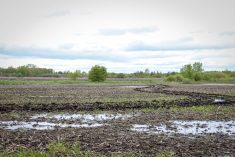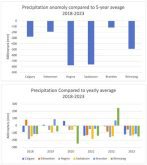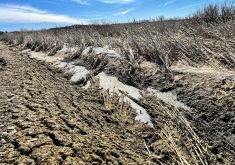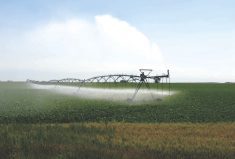Manufacturers may start reducing wool content in clothing
By Jonathan Barrett
Yennora, Australia | Reuters
Auctioneer Ian Sharp has been selling Australian agricultural products to the highest bidder since 1968, and he’s never seen demand like this before.
Earlier this year, the benchmark price for fine Australian merino wool gained a foothold above the once mythic A$20/kg (about $6.60/lb.) price, as one of Australia’s worst-ever droughts leaves farmers struggling to keep flocks fed.
The surge, up 20 per cent in a year, has confounded buyers who have waited in vain for prices to fall, as they have done previously.
Read Also

June brings drought relief to western Prairies
Farmers on the Canadian Prairies saw more rain in June than they did earlier in the 2025 growing season
“This is very exciting for an old auctioneer like me in the fact that we are selling at these prices and we are clearing a lot of wool,” Sharp told Reuters, shortly before an auction at one of the country’s biggest wool-selling sites, in Sydney’s western suburb of Yennora.
“There’s very little wool on hold anywhere on farms or woolbrokers’ stores.”
Australia controls 90 per cent of global fine-wool exports, where demand is being driven by Chinese wool mills and Italian garment makers, according to wool brokers at the Yennora auction.
While wool has long been used by suit makers, the surge in popularity is being driven by fitness and leisure clothing manufacturers looking for soft, durable and natural fibres.
But the drought savaging Australia’s east, where the bulk of the country’s wool is produced, is hitting flock numbers, leading to lower production, threats to quality, and higher prices.
Thirsty buyers, parched sellers
Like any commodity, wool has had its ups and downs, with sharp price spikes followed by troughs.
Wool buyers say this has prompted many overseas buyers to run down their stocks and wait for prices to fall.
“I think going back a few months people were prepared to believe this market could correct in a big way — that’s gone now,” said Peter Brice of Australian Merino Exports, which has a big base of Chinese clients who mill the raw wool into fabric.
“We think from October onwards they will need to stock the pipeline up again knowing the further we go, the less wool there will be. The threat of a fairly dramatic reduction in supply next year is really underpinning this market and I think the Chinese in particular now appreciate that.”
Many Australian farmers, meanwhile, are selling their older sheep to reduce their exposure to rocketing feed costs as the drought lingers, and to take advantage of high mutton prices.
Lamb and sheep sales are running at around 15 per cent more than this time last year at the large sale yards in the NSW regional city of Wagga Wagga, according to livestock agent Isaac Hill.
Australia’s chief commodity forecaster ABARES anticipates wool production will drop four per cent this financial year to 404,000 tonnes, the first annual decline in four years.
Sheep numbers are also expected to fall this year, down three per cent to 69.1 million, according to ABARES.
The supply imbalance is hard to correct. While New Zealand, South Africa and Argentina also export merino wool, it takes years to build flocks, making it difficult for other countries to quickly respond to demand.
What next?
The question of what happens next in the wool market is complicated by its opaque nature, according to analysts.
Unlike more transparent markets like cotton, analysts have a much harder time looking through the wool supply chain to measure global stock levels and anticipated demand.
Australia’s weather will also play a part.
Wool traders at the Yennora auction told Reuters more dust was turning up in the wool as a result of the drought, although the overall quality was still sound.
If rural conditions deteriorate, dirt and other impurities will start to reduce the quality of the fleeces. Underfed sheep could also be a problem, given they produce weaker fibres.
David Hart, wool manager at broker Landmark, said high prices were posing some problems for supply chains that ultimately produce a woollen garment.
“There is difficulty passing on these prices down the pipeline — so far the shortage of supply has ensured the wool has kept flowing because there is demand for the final product and so that pulls the wool through the system.”
Manufacturers may start decreasing the wool content, substituting in lower-cost fibres such as cotton and polyester, when they renegotiate new season production contracts, according to a September note by forecaster ABARES.
Any substitution is expected to occur with lower-margin, mass-produced garments, as opposed to tailored suits, for example.
Dry weather saps demand for herbicide, fertilizer
By Tom Westbrook and Colin Packham
Sydney | Reuters
Australian crop protection company Nufarm Ltd. reported an annual loss on Sept. 26 as a severe drought cut domestic sales, prompting it to slow down production, write down its business and launch a capital raising.
Nufarm’s woes augur badly for other firms exposed to Australia’s rural sector, which is struggling through the driest conditions in decades across the country’s east. The company said a recovery was likely in 2019, but this would depend on a return to “more average conditions” by winter.
Australian farm conditions have worsened since Nufarm issued a profit warning in July, with wheat production cut to its lowest in a decade, the wool clip set to drop and weather forecasters offering no relief in sight.
The country’s east coast has recorded less than a fifth of its typical rainfall over the last three months and farmland there is bone dry, with winter crops failed and graziers buying in grain to feed their herds.
“In important cropping regions in eastern Australia we have experienced the driest conditions in some 100 years,” Nufarm chief executive officer Greg Hunt told analysts on a conference call.
Without viable harvests to protect, farmers had no use for the company’s products, especially herbicides, he said, leaving inventory stuffing warehouses and store shelves and creating a backlog that must be cleared before the products expire.
Australian and New Zealand sales fell 10 per cent.
Meanwhile, the company has been cancelling raw material orders and working its herbicide plants at “minimal levels of activity,” as farmers wait for rainfall, said chief financial officer Paul Binfield.
Germany to become net grain importer after drought — USDA
Hamburg | Reuters
Germany, in most years one of the EU’s largest grain exporters, is expected to become a net importer after a hot, dry summer damaged crops, said a report from the U.S. Department of Agriculture’s Global Agricultural Information Network (GAIN).
“The drought has heavily affected grain, rapeseed and forage production in Germany,” said the report. “As a result, Germany is expected to strongly increase imports of soybeans/soybean meal and to become a net grain importer.
“The U.S. is set to become top source of soybeans to Germany.”
Germany’s Agriculture Ministry forecast in August the country’s 2018 grains harvest would fall 15.8 per cent on the year after crops suffered from drought and hot weather.
Its winter rapeseed harvest, the main oilseed for edible oil and animal feed production, was forecast by the ministry to fall 14.5 per cent on the year.
German crops wilted under the highest summer temperatures since records began in 1881 and prolonged dryness.
“Use of domestic grains and rapeseed meal in (animal) feed rations is set to decrease in the remainder of 2018 and for at least the first half of 2019,” the GAIN report said. “This is partly because of the low domestic grains and rapeseed production and partly because of higher compound feed use.”
Higher use of manufactured compound animal feeds is a result of the lower German on-farm production of feed grains, it said.
Germany’s potato harvest falls 25 per cent after drought
Hamburg | Reuters
This summer’s drought and heat wave will cut Germany’s potato harvest by around 25 per cent on the year to about 8.7 million tonnes, the country’s Agriculture Ministry said on Sept. 26.
The reduced potato harvest is the latest in a series of bad news after German crops wilted under the highest summer temperatures since records began in 1881.
Germany’s Agriculture Ministry forecast in August the country’s 2018 grains harvest would fall 15.8 per cent on the year after crops suffered from drought and hot weather. This could make Germany, traditionally a grains exporter, into an importer.
The smaller potato crop means a tighter market supply at a time when other northwestern European producers including France, Britain, the Netherlands and Belgium also suffered from the heat wave, the ministry said.
“This is meeting high demand from industry, such as for potato fries and crisps,” the ministry said. “This means producer prices against this background are well above last year’s very low levels.”



















